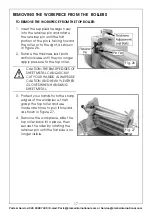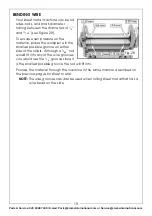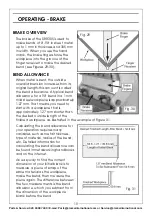
14
Parts & Service: 020 8988 7400 / E-mail: [email protected] or [email protected]
NOTE:
If your workpiece has an
undesired initial flat, as
illustrated in Figure 19, you
can remove it by flipping the
workpiece around and pass
it through the front of the
machine so that the initial
flat enters last.
4. Slightly tighten the diameter
adjustment knobs the same
amount, then pass the workpiece
through the rollers again.
NOTE:
To make a cone, tighten one adjustment knob more than the other.
5. Repeat Step 4 until you have produced the desired curve.
CREATING CYLINDERS
If you know the diameter of the cylinder you want to create, use the formula
below to calculate the length of material needed.
C=
π
D
C = Circumference (Length of Material Needed)
π
= Pi (Approximately 3.142)
D = Diameter
Example: Suppose you want to create a 150 mm diameter cylinder. You would
use the above formula as follows:
C =
π
D
C = (3.142) x 150 mm
C = 471.3 mm
The result of 471.3 mm indicates that you need to start with a piece of sheet
metal that is approximately 471.3 mm in length in order to create a 150 mm
diameter cylinder.
Fig. 19





























